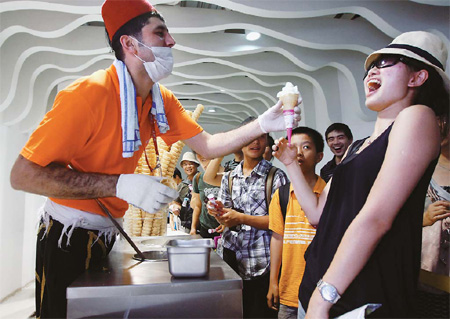|
 An ice-cream vendor in the Turkey Pavilion hands out a traditional maras ice cream to a delighted visitor. Photos by [Gao Erqiang / China Daily]
An ice-cream vendor in the Turkey Pavilion hands out a traditional maras ice cream to a delighted visitor. Photos by [Gao Erqiang / China Daily] |
Crowds are flocking to the Turkey Pavilion to learn about their futures and sample icy treats, Yu Ran reports.
With artists creating unique work, ice-cream makers stirring up delicious treats and fortunetellers looking into the future by interpreting coffee grains, the Turkey Pavilion has become one of the most popular in the Expo Garden.
The theme of the pavilion is inspired by Catalhoyk, one of the first known settlements in the world, and features relics of different civilizations. The relationship between Turkey and China is shown through "Dreaming of the Past", which features ancient Chinese and Turkish clocks with 12 zodiac signs, and the earliest China-Turkey agreement carved on a stone table.
But more enticing to visitors are the food, beverages and art.
Maras ice cream is famous worldwide for its unique taste. Visitors wait in long lines in front of the ice-cream vendor in the pavilion to taste the delicious treat and have their picture taken with the ice-cream maker.
"I prefer a strong tasting ice cream very much and that's what Turkish ice cream is famous for. I like the strong milky flavor and the smooth taste of the ice cream," said Zhang Qichang, a visitor from Jiangsu Province. "The way he makes the ice cream is funny, too."
Art enthusiasts will enjoy watching demonstrations of ebru, the Turkish art of paper marbling. The patterns are created using floating dyes and then carefully transferred to a sheet of paper or other surfaces.
Murat Elhan, the 35-year-old artist, intrigues visitors with this traditional Turkish art.
"The liquid is a mixture of a plant called geven, which dissolves in water easily and is very sticky. The colorful pigments are special mixture to open the surface up," said Elhan, explaining the principle of paper marbling.
Elhan started learning paper marbling when he was 10 years old. He has to plan and design clearly what he is going to make before starting the work.
"It seems hard work, but actually it was quite easy and accessible for everyone. It's better to have a creative mind and open imagination for unique and colorful artworks," Elhan said.
Whenever Elhan finishes a new work, he receives warm applause from the visitors who admire his performance.
For a more supernatural experience, the pavilion features an exotic form of fortune telling. Tasseography is a traditional form of seeing into one's future by interpreting coffee grounds. The cup is turned over into the saucer to cool, and then the patterns of the coffee grounds can be used for a kind of fortune telling.
"Turkish fortune telling is totally different from the Chinese traditional way, where they need your date of birth and the eight characters of a horoscope," said Wang Chunxia, a visitor from Shandong province. "I didn't tell her anything but she was explaining the future for me."
Deniz Genez Aydin, 45, the fortuneteller in the Turkey Pavilion, majored in technological management and runs a business consultant company in Shanghai. This form of traditional fortune telling has been her hobby since she was 15 years old and is a family tradition.
"The coffee fortune telling is a type of psychological therapy to assist people to make decisions and help them see the opportunities that they ignored. I could pick up the sign for you and you have to open your mind and think more by yourself," said Aydin.
Turkish coffee differs from percolator and instant varieties by how it is ground and served. Coffee beans are roasted a few times and then finely ground. Turkish coffee is prepared in tiny pots called cezve, which can only hold about two cups.
"I believe that everyone has the potential and capabilities to see the future because we all have the sixth sense. Nobody knows the exact future because it is totally up to us, up to our decisions," said Aydin.

